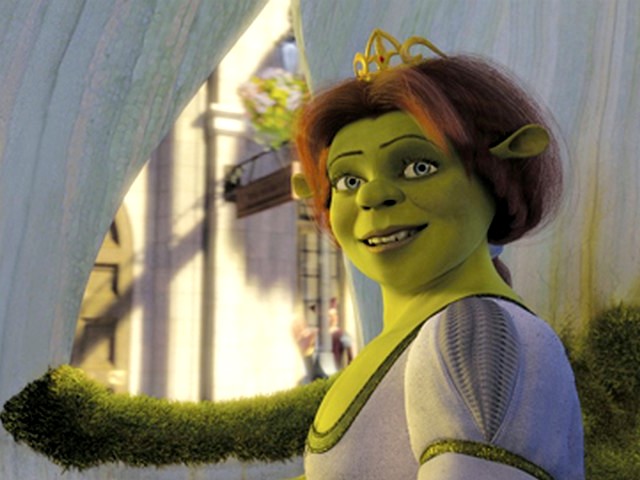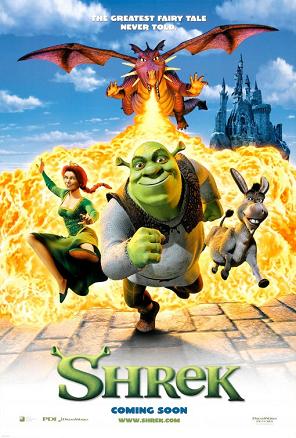 |
| Princess Fiona |
This is a guest post by Megan Wright.
When I first watched Shrek, I can’t really remember how I felt about Fiona, aside from the fact that I thought it was fantastic that she was fighting Robin Hood and his Merry Men. As the years passed, I bought the movie, and it was also broadcasted on several channels. It was almost impossible to go a year without seeing it. So, as I watched it more and more, I could figure out the underlying themes in Shrek: appearances don’t matter, the locking away of those perceived as different is wrong, and that talking donkeys are awesome. But the most important theme of the movie is how a strong woman almost gets tricked into a loveless marriage because of her low self worth, all due to the standards of beauty society imposes on her.
I’m talking, of course, about Princess Fiona. Fiona is meant to be a deliberate contrast to the stereotypical princess. Her elaborate way of talking is forgotten in favor of insulting Shrek. When Robin Hood tries to rescue/abduct her, she promptly beats the crap out of him. She sings, but when she does, she accidentally blows up a bird. During her years in a tower, Fiona hasn’t simply gazed out a window, but instead taught herself first aid and martial arts. She doesn’t take Shrek’s plan to get her back to Farquaad happily. When Shrek complains that it’s his job, she replies “Well, I’m sorry, but your job is not my problem.” She knows the way she wants this rescue to go, damn it, and she’s not going to go along with Shrek’s plans simply to make it easier on him.
 |
| Princess Fiona, not in Ogre form |
So why does she get bullied into marrying Farquaad?
The problem is that Fiona lives in a world that tries to separate anyone who doesn’t fit the ideal representation of perfection. Lord Farquaad first talks about it, saying that the fairytale creatures are ruining his “perfect kingdom.” Shrek shows a world that really isn’t too different from our own. Sure, the segregated group includes talking pigs, wolves that enjoy dressing like grandmothers, witches riding on broomsticks, but their problems are still similar. The fairytale creatures are kicked off their land and moved into an inhospitable area (Shrek’s swamp) simply because they don’t fit the norms of Farquaad’s perfect kingdom. It’s not that far off from real world situations.
Here’s an example of how much beauty means in this world–in the beginning of the movie Farquaad uses a magic mirror and is given a list of several princesses to choose from to make into a queen. One of those princesses is Snow White, who later shows up in Shrek’s swamp, exiled with the dwarfs. This sends the message that if magic can help him obtain a beautiful wife, then he’s fine with it. It’s only the “undesirable” fairytale creatures that we see Farquaad hates. Throughout the movie we think that Farquaad hates fairytale creatures, but he doesn’t. He hates the fairytale creatures that don’t match up to his obsessive standards of beauty.
It’s almost no wonder that in this world, Fiona would be desperate to become someone who wasn’t ostracized, or excluded. Fiona’s sole reason for getting married is that she wants to fit into society.
Fiona’s been raised on traditional fairytales, on handsome princes rescuing fair maidens from curses. Her parents stuck her in a tower for almost all of her life, keeping her from realizing that, just maybe, being an ogre isn’t the worst thing in the world. Fiona’s strong and capable, but she’s also been extremely sheltered. She’s constantly been taught that being anything other than the princess in the traditional fairytales is wrong, and she’s never seen examples to prove otherwise.
That’s why when Shrek walks into her life, she starts to come out of her shell. Here is someone different from society, someone like her, and he’s kind and warm (to her, at least). He’s not even lacking in companionship–he’s got Donkey for a friend. With Shrek, Fiona slowly begins to realize that it’s okay to be an ogre.
 |
| Princess Fiona and Shrek |
Still, Fiona’s self-loathing over her ogre self goes extremely deep. When she confesses that she’s an ogre to Donkey, she says that no one would want to marry a beast like her. Shrek overhears this, and believes she’s talking about him. When he confronts her about it, and throws her words back in her face, she immediately assumes he’s talking about her. Fiona has overheard Shrek make comments about his identity as an ogre and the issues that come with it, so it wouldn’t be a huge leap for her to consider the possibility that Shrek overheard her and thought she was talking about him. But Fiona’s self loathing runs so deep that she doesn’t even consider the possibility.
Ironically, Fiona doesn’t even seem to focus on the fact that if Shrek is rejecting her, he’s also rejecting himself. After all, he’s an ogre just like her. But, again, she loathes herself so much that she doesn’t even think of that.
Fiona’s marriage to Farquaad is, even from the beginning, one of desperation, not love. She wants to love him because she wants to believe that his kiss will break her spell. When she later realizes that he’s a jerk, she still goes along with the marriage because she wants to have the curse removed. It’s been so ground into her that being different is horrible, that she believes, even though she doesn’t love Farquaad, the kiss of someone “normal” will make her better.
In the short amount of time that we see Fiona engaged to Farquaad, we see that she loses a lot of the character traits that she shows throughout the movie. She reverts back to the eloquent talk that she had in the beginning; she passively sits around waiting for the wedding to start; and she doesn’t speak up for herself, even though she’s clearly miserable. By reverting to the expectations society has for her, she’s “normal” but unhappy.
That’s why the climax of the story, where Fiona reveals that she’s an ogre, is so powerful. By revealing herself to Shrek as an ogre she’s saying that she can’t let him love her, if he can’t love all of her.
 |
| Shrek and Princess Fiona |
It’s symbolic that Fiona’s ogre self, the self that has been rejected by society, is Love’s True Form. It doesn’t match up to society’s standards (which makes sense, because society’s standards told her to marry the heartless Farquaad), but it’s the best version of Fiona.
Fiona’s rejection of Farquaad’s marriage proposal is a rejection of the conventional life she’s been taught to want. When Fiona accepts Shrek’s love, she also accepts herself. By Fiona embracing Love’s True Form, she embraces the life that she secretly wants–a life as the best, truest version of herself, no longer in hiding.
Megan Wright is a TV reviewer and co-editor for Watch It Rae! She can be found glued to her computer blogging about her favorite TV shows, movies and books.




